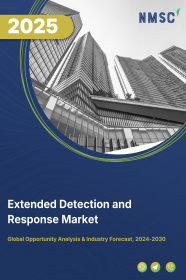
Extended Detection and Response Market by Component (Solution and Service), by Deployment Model (On-Premise and Cloud), by Enterprise Size (Large Enterprises and SMEs), by Industry (BFSI, Government, Manufacturing, Energy & Utilities, Healthcare, Retail & E-Commerce, IT & Telecom, and Others)- Global Opportunity Analysis and Industry Forecast 2022-2030
Market Definition
The Extended Detection and Response Market was valued at USD 1.01 billion in 2021 and is predicted to reach USD 4.67 billion by 2030, expanding at a CAGR of 18.8% from 2022 to 2030.
Extended detection and response is a cybersecurity system that detects and mitigates cybersecurity threats. It is an innovative threat detection and response method, offering comprehensive protection against cyberattacks, unwanted access, and data exploitation. This system gathers and correlates data from numerous network points such as email, servers, cloud workloads, and endpoints.
Market Dynamics and Trends
The demand for extended detection and response is witnessing an uptick due to the rising number of data breaches and online frauds globally, leading to various organizations adopting edge-computing and decentralized security measures. According to the report published by SonicWall cybersecurity system, in February 2022, globally 623.3 million cyberattacks were registered in 2021.
Also, the growing trends of adopting bring your own device (BYOD) along with enterprise mobility trends across organizations including government, IT & telecommunication, and BFSI sectors is further boosting the growth of the extended detection and response market. Moreover, the growing organizational investment in endpoint detection and response (EDR) tools to address the growing challenges of sophisticated attacks, insider threats, and advanced persistent threats (APTs) is fueling the growth of the extended detection and response market.
However, the lack of effective security automation along with the high infrastructure investment cost of extended detection and response system is expected to restrain the growth of the market. On the contrary, the introduction of modern technologies such as machine learning (ML), artificial intelligence (AI), and behavioral analytics in threat detection, is expected to create ample growth opportunities for the market in the future.
Market Segmentation and Scope of Study
The global extended detection and response market is segmented based on component, deployment model, enterprise size, industry, and geography. Based on component, the market is classified into solution and service. Based on the deployment model, the market is segmented into on-premise and cloud. On the basis of enterprise size, the market is categorized into large enterprises and SMEs. On the basis of Industry, the market is divided into BFSI, government, manufacturing, energy & utilities, healthcare, retail & e-commerce, it & telecom, and others. Geographical breakdown and analysis of each of the aforesaid classifications include regions comprising North America, Europe, Asia-Pacific, and RoW.
Geographical Analysis
North America dominated the global extended detection and response market in 2021 and is potently expected to remain dominant throughout the forecast period. This is attributed to the increased investment in research & development activities by the governments to improve the detection and prompt response to cyber threats. For instance, in August 2021, the United States Senate passed the infrastructure investment and jobs act for cybersecurity infrastructure development.
Also, the presence of major market players such as Cynet, IBM Corporation, and Palo Alto Network which are undertaking various strategies including innovation and collaborations in the region is further accelerating the growth of the market. For instance, in November 2021, Cortex launched Cortex eXtended Managed Detection and Response (XMDR) partner specialization to help consumers to detect, investigate and respond to cyber threats.
Asia-Pacific is anticipated to exhibit substantial growth in the global extended detection and response market during the forecast period, owing to the rapid proliferation of cloud computing, internet of things (IoT), and system as a service (SaaS) technology in developing countries such as India and South Korea. Also, the growing IT spending and an increasing number of data breaches are the key factors driving the regional market growth.
According to the report published by CNN in July 2022, in China, approximately 1 billion people faced a data breach in 2021. The report highlights the scale and severity of data breaches in China and underscores the urgent need for organizations and governments around the world to prioritize the protection of sensitive information and to implement robust cybersecurity measures to safeguard against such incidents.
Competitive Landscape
The extended detection and response market includes several market players such as Bitdefender, Broadcom Corporation, Cisco Systems Inc., Cynet, McAfee Corporation, Microsoft Corporation, Palo Alto Networks, IBM Corporation, Sophos Ltd., and SentinelOne Inc. among others. These market players are adopting various strategies such as innovation and collaboration to maintain their dominance in the global extended detection and response market.
For instance, in October 2022, Cynet collaborated with TD SYNNEX. This collaboration was aimed to expand the distribution of Cynet’s cybersecurity platform to provide automated and comprehensive protection against cyber-attacks. Also, in April 2022, Bitdefender launched the extended detection and response (XDR) solution, GravityZone to improve cyber resilience. The objective of this launch was to deliver rapid value by helping maximize security team effectiveness, improving threat hunt efficiency, minimizing attacker dwell time, and enabling greater cyber resilience.
Key Benefits
-
The extended detection and response market report provides a quantitative analysis of the current market and estimations through 2022-2030 that assists in identifying the prevailing market opportunities to capitalize on.
-
The study comprises a deep dive analysis of the extended detection and response market trend including the current and future trends for depicting the prevalent investment pockets in the market.
-
The information related to key drivers, restraints, and opportunities and their impact on the extended detection and response market is provided in the report.
-
The competitive analysis of the market players along with their market share in the extended detection and response market
-
The SWOT analysis and Porter’s Five Forces model are elaborated in the study.
-
Value chain analysis in the market study provides a clear picture of the stakeholders’ roles.
Key Market Segments
By Component
-
Solution
-
Service
By Deployment Model
-
On-Premise
-
Cloud
By Enterprise Size
-
Large Enterprises
-
SMEs
By Industry
-
BFSI
-
Government
-
Manufacturing
-
Energy & Utilities
-
Healthcare
-
Retail & E-Commerce
-
IT & Telecom
-
Others
By Geography
-
North America
-
U.S.
-
Canada
-
Mexico
-
-
Europe
-
UK
-
Italy
-
Germany
-
Spain
-
Netherlands
-
Rest of Europe
-
-
Asia-Pacific
-
China
-
Japan
-
India
-
Australia
-
South Korea
-
Taiwan
-
Vietnam
-
Rest of Asia Pacific
-
-
RoW
-
Latin America
-
Middle East
-
Africa
-
KEY PLAYERS
-
Bitdefender
-
Broadcom Corporation
-
Cisco Systems Inc.
-
Cynet
-
McAfee Corporation
-
Microsoft Corporation
-
Palo Alto Networks
-
IBM Corporation
-
Sophos Ltd.
-
SentinelOne, Inc.




















 Speak to Our Analyst
Speak to Our Analyst

























